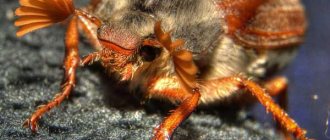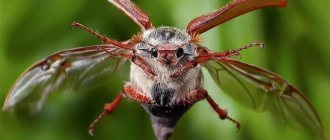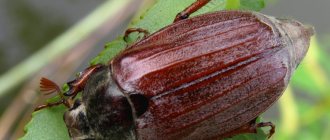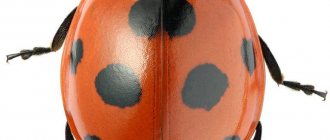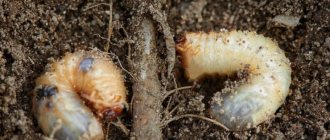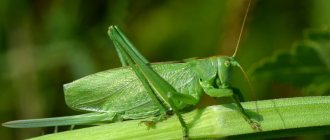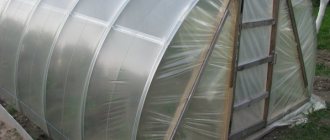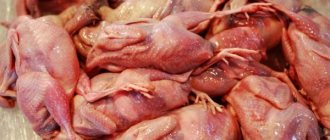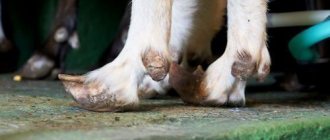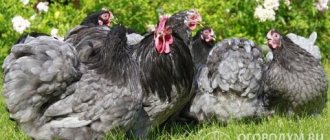May beetles or May beetles (Melolontha hippocastani) belong to the phylum Arthropods, class Insects, genus Melolontha.
This genus consists of 24 species, 9 of which live on the territory of the Russian Federation. The mass appearance of cockchafers occurs in the spring, most often at the end of April and May. Phenologically, the period of appearance of these beetles coincides with the beginning of oak buds and the mass leafing out of birch trees. If you look closely at the ground on these warm spring days, you can see cockchafers crawling out of it after wintering and flying into the air.
On spring evenings, especially near green, flowering trees, you can often hear them buzzing and see them flying.
Landing on trees, they damage young leaves and flowers, so May beetles cause enormous damage to agriculture and forestry. And during the day you may not notice these beetles on a tree or bush; they sit there, clinging to the branches with their legs.
Appearance of the cockchafer
The body of the cockchafer, like most insects, is covered with a chitinous shell, performing the functions of an external skeleton and protection.
Sizes of the cockchafer
The beetles reach a length of 2 to 3.5 cm.
May beetle coloring
Adult individuals are characterized by color dimorphism, that is, individuals may differ in color from each other.
In general, entomologists distinguish two color varieties (aberrations) of chafer beetles: red with a red pronotum and legs (rex) and black with black pronotum and legs (nigripes). These aberrations are considered to be ecological forms of Mayweed.
Beetles with red coloration mainly live in open places with weak shade, while beetles with black coloration live in shaded places, including under the canopy of not very dense forests. Red beetles are found mainly in the northern regions, and black ones in the southern regions. In the center of the species' range, there are approximately equal proportions of beetles of both varieties.
Habitats
May beetles live in Europe and Asia, mainly inhabiting forest-steppe and forest zones, preferring young pine forests.
Within the city limits, these beetles can often be seen in artificial plantings and near flowering fruit trees and shrubs. On trees or shrubs, the beetles feed and mate, after which the females lay eggs, burrowing into the soil.
Every spring, when young leaves bloom on the trees, a red-brown beetle covered with delicate white hairs emerges from the soil to the surface. Usually this event goes unnoticed by most people, as it happens in the evening and far from our home. Only later, when we see an insect in a park or garden, will we say: “Here comes the cockchafer!”
He usually comes out somewhere in a meadow or in. field, looks around, moves his chocolate mustache and, making sure that there are no trees or bushes in this place, goes in search of food. He makes energetic movements with his abdomen, as if pumping air into himself, spreads his wings and takes off.
A school textbook on zoology reports: “When flying, the elytra have the same importance for a beetle as the bearing planes for an airplane, and the wings serve as propellers.” This is, of course, true, but in reality everything is much more complicated. According to the laws of aerodynamics, a beetle should not fly: its lift coefficient is too low. The beetle, of course, knows nothing about this and flies around quietly, perplexing the experts. Scientists film a flying beetle and construct wing models. L. Bennett (USA): “If we are able to determine the aerodynamics of the cockchafer’s flight, we will either discover some imperfection in the modern theory of insect flight, or we will discover that the cockchafer has some unknown method of creating high lift.” Aircraft designers are closely monitoring this work.
The flight speed of the cockchafer is two to three meters per second, its wings make 46 beats per second. On clear days, beetles are capable of making twenty-kilometer flights. They always fly in a straight line, at an altitude of six to 100 meters.
In flight, the beetle stops breathing, and it seems that the height takes its breath away. But in the laboratory, forced to fly, the beetles absorbed a volume of oxygen equal to their body volume in two minutes. This is understandable: the wing muscles work intensively. But how does breathing go during flight? Why do Khrushchev have so many air sacs inside? All this, unfortunately, remains unclear.
So, the beetle, soaring vertically upward, makes an introductory flight in a spiral and flies to... Here it must be said that there are two types of May beetles: eastern and western. So, from the field the eastern one flies to the nearest forest or tall trees. Their silhouettes stand out clearly against the background of the dimly lit twilight sky. Western Maybirds head for the highest objects above the horizon. These are usually wooded hills.
If a beetle was born in a mountain valley, then it flies to the highest visible mountain range. If the ridge is further than two kilometers, then the Khrushchev does not risk embarking on such a long journey, but chooses landmarks closer. If, having reached the place, he discovers that there is no food (forest) here, that the high point is just bare rocks, he selects a new high landmark and flies to it.
In flight, the beetle is very purposeful and it is not easy to lead it astray. What biologists have not done with beetles caught in flight! They put us in boxes with holes. They cooled, heated, and acted with different gases. They were caught and released ten days later, and in a different area. But every time, finding themselves in the wild, the beetles stubbornly continued to fly in the same direction in which they flew before being caught. The inventive Frenchmen P. Robert and A. Couturier enveloped the edge of the forest where the Khrushchevs were heading with a huge cloud of artificial fog up to a kilometer long. This did not bother Zhukov. They went around the obstacle from above, in a narrower place where the fog came out of the device, and continued the flight “according to a given program.”
If captured beetles are taken outside the forest to which they were so eager and released at the edge of the forest, they stubbornly fly in the same direction. True, now they are not approaching the forest, but moving away from it. But the “fly forward” program is being carried out steadily.
What is the reason for this constancy? Where does Khrushchev hide the “compass and map”? A complete answer is still far away, but much has already been clarified.
Firstly, the cockchafer navigates by the sun. Caught in the evening and released during the day, it will fly on the same course if the sun is visible. In some experiments, the beetle was masked from the real sun in the sky and presented with its image in a mirror. The deceived beetle changed its flight direction. True, in the evening the beetle finds its direction even when the sky is covered with clouds, and even later, when the luminary goes beyond the horizon. The fact is that although the sun is invisible, the sky is illuminated by so-called polarized light. The beetle (as well as flies, bees, ants, spiders) uses it for orientation.
Secondly, it is assumed that the cockchafer is able to simply remember the area, navigate by its appearance, by noticeable, catchy objects. Here the beetles are similar to bees and wasps.
Much in the behavior of the cockchafer remains unclear. It has been proven, for example, that at rest it positions the body in the direction “north-south” or “west-east”, that is, it somehow reacts to the magnetic field. Khrushchev is also affected by electric and gravitational fields. And according to F. Schneider, who performed careful and numerous experiments, the beetle is influenced by some unknown factor. It acts very rarely, and these days coincide with the same phase of the moon.
But finally, the goal was achieved - a landing party of beetles landed on the edge of the forest. Now is the time to refuel: after all, they have not eaten anything for eight months, having been in hibernation since last summer. The beetles greedily pounce on young foliage.
In matters of nutrition, the cockchafer has broad views. It devours the greenery of oak, poplar, willow, maple, grape, gooseberry and many other trees and shrubs. He does not disdain flowers and ovaries of fruit crops, pine needles. The only thing he doesn’t eat is ash, and the western May beetle also refuses lilac.
Eating leaves, the beetles fly from tree to tree, from one area to another. In large areas they move from the edges into the depths of the forest. Khrushchev avoid shaded places and mostly stay near clearings, clearings, and clearings.
They need light: the cockchafer lives by the sundial. The rhythm of his life is determined by the sun. During the day, the beetles are inactive, sit on trees and seem to sleep. In the evening their activity increases; at dusk and at night they feed and fly with might and main.
At first glance, it seems that the beetle reacts to light: a lot of light - inactive, little - active. But it's not that. The spectral composition of light is important. The beetle is very sensitive to violet and ultraviolet rays, they cause its mobility and stimulate it to fly. There is a lot of such light after sunset and before sunrise, when the sky is lilac. And the blue color sharply inhibits the activity of beetles. That is why clear skies during the day do not inspire them to travel.
After one to three weeks, hormones begin to circulate in the females’ bodies, which dramatically change their behavior. They become very mobile and eventually fly away. It is not clear how, but they remember the direction of their first flight and fly in the exact opposite direction. No changes in the situation confuse them. If, while feeding, a beetle made its way through the entire forest and came to another edge, then now it will fly back to the one from which it came, although in front of it there seems to be the same edge. If the beetles crossed a mountain range on their first flight, they return to the valley of their birth, although it is closed by mountains, and another valley is in front of them. The flight takes place in any weather. As you can see, beetles are very attached to their native land.
The destination may be near the edge of the forest, or it may be two to three kilometers away. Fields, meadows, high grassy hills - this is what females look for. They fly to lay eggs.
Freshly laid May beetle eggs die from contact with air. Therefore, before starting laying, the female burrows 10–12 centimeters into the ground and lays several piles of eggs there. Then it returns to the trees, feeds and flies back to the field. In two or three such sessions, she lays 60–70 eggs. Flying, digging, and egg-laying take a lot of energy from females. After the last visit to... field they die right in the soil. Sometimes this happens after the first laying. Males die even earlier. Well, the beetles have fulfilled their duty to the species. The life of the species will continue.
The larvae of the cockchafer are white worms with red legs and heads. At first, they eat dead plant remains, and as they get older, they switch to living roots. What is missing in their diet: all fruit trees, berry bushes, cereals, acacia, tobacco, pine, flax, onions... Future beetles develop and grow most quickly on the roots of beets, carrots, dandelions, sunflowers. The larvae detect their food by the carbon dioxide released by the roots. It is impossible for plants to escape: to do this they would have to stop breathing.
The larvae eat and become longer and thicker. For the winter they go deeper into the soil; when it gets warmer, they return to the top. Because of this, the cockchafer does not settle in places where permafrost or soil waters come too close to the surface. The structure of the body helps the larvae to travel. One might say that the larvae pave their way in life with their heads. It moves the soil apart, its jaws gnaw off particles of earth, and its legs push them back. The body that looks like the letter “C” helps to push and push.
Three, and in the north even four, years pass in such matters and concerns. An adult beetle lives for a maximum of several months, and a larva lives for several years.
Its length reaches six and a half centimeters, twice the size of an adult beetle. After wintering for the last time, in the summer the larva makes a cradle for itself, where it then turns into a pupa. An adult beetle usually emerges from it at the end of summer. He is in no hurry to get up and sleeps in his shelter until spring, as if he knows that his name is May.
They say that sometimes beetles wake up at completely inopportune times. In December 1854, a cockchafer flew into a room where a meeting of naturalists from Saxony and Thuringia was taking place. And one day in February he flew into a public carriage, quite surprising the frozen passengers.
However, the cockchafer is widely known not so much for its interesting properties as for the harm it causes. The larvae are especially dangerous. The third instar larva completely eats the roots of a two-year-old pine tree during the day. The activity of beetles and their offspring can destroy extensive forest plantations, nurseries, beet plantations, and young orchards.
The first attempts to combat the beetle were made in the Middle Ages. Switzerland, 1479. There is a real trial going on over the May Khrushchevs. Maggots are blamed for causing orchards to collapse. During the investigation, the beetles' guilt was completely proven. No matter how hard the resourceful lawyer tried, his clients were sentenced to exile. Either the beetles did not consider themselves guilty, or they did not understand the essence of the sentence, but they continued their devastating work. Meeting the wishes of the parishioners, the bishop intervened in the matter: “Stupid, unreasonable creatures! There were no cockchafer larvae in Noah's Ark. In the name of the most merciful Lord, I command you all to leave for six days from all those places where food grows for people and livestock.” A dispute broke out: was there a beetle among Noah’s passengers? The discussion was not decided in favor of the beetles. The Bishop of Lausanne took extreme measures: “... we expel you, disgusting worms, and curse you!” But this measure did not give the desired results. Then, with a brilliant maneuver, the clergyman saved his reputation. He announced that Khrushchev was God’s punishment for the sins of careless parishioners...
For a long time, beetles were simply collected by hand. In the early morning, insects numb from the cold can be easily shaken off, raked up and destroyed. In Germany, during mass reproductions of the beetle, areas of deciduous trees were cut down and only a few were left for bait. If you put it on a grand scale, hand picking gives amazing results. In 1868, about three thousand tons of beetles were collected in Saxony. In 1928, 44 tons of beetles were collected in Buzuluksky pine forest (Voronezh region). Usually this “harvest” was burned, buried, and sometimes fed to pigs and poultry. According to A. Bram, doctors recommended a “strengthening broth” made from cockchafers to those recovering.
During the First World War, the journal Nature discussed the use of cockchafer larvae for human food. Recipes for dishes were offered (something like porridge made from chopped maggots with milk), which, as the magazine reports, delighted the tasters. And, most importantly, how easy it was to get the meat! “It’s enough to send a boy with a bucket for the plow...”
In the 30s, a recipe was even proposed for making cheap and, allegedly, good... soap from beetles.
It is clear that manual collection requires a huge investment of time and many hands. Therefore, it was supplanted by chemical weapons, which are now the main means of destroying the pest. Khrushchev fodder plants are sprayed with pesticides, which are also applied to the soil. As you know, the negative consequences of chemical warfare against insects have recently become clear. Having not solved all the problems, pesticides created new ones.
Insecticides were used against chafer larvae in the meadows of Switzerland. However, the next year, the areas not treated with poison, where the larvae continued to live, produced no less hay than the treated ones. The reason is unclear, but it is clear that pesticides must be used very carefully.
Intensive development of non-chemical methods of pest control is underway. They are also tested against the May Khrushchev.
First of all, Khrushchev has many enemies in nature. Parasitic insects use the living beetle and its larvae as food for their offspring. Khrushchev is eaten by predatory ground beetles. Diseases and death of the beetle are caused by more than one hundred and fifty species of bacteria and fungi. Successful experiments have been carried out on their use against Khrushchev.
Large beetles and their fatty larvae are delicious food for cuckoos, magpies, jays, starlings, orioles and other birds. Taking care of your feathered friends is also pest control.
In the Dergachevsky district of the Kharkov region, from the forest where the fight against Khrushchev was not carried out, he annually made predatory raids on a flowering garden nearby, eating cherries, apple trees and especially plums. In 1956, cultivation of the garden attracted jackdaws to the area. They chose their food from the loose earth, and then an invasion of beetles began from the forest. The birds quickly found their bearings and switched to new food. They dropped the beetles on the ground and then pecked them without interference. And if before the intervention of the jackdaws there was an average of 154 beetles per tree in the garden, then after five days only a few miraculously surviving pests could be found.
We tried to fight the beetle and “atomic weapons” - radioactivity. In experiments over 16 days, the Khrushchev received a radiation dose eight thousand times greater than what is permissible for humans. The branches of the trees on which the insects fed died. The beetles became infertile, but remained quite alive. Moreover, the irradiation even slightly cheered them up: activity increased, mortality decreased, although their appetite remained the same. Thus, this method turned out to be unsuitable for destroying beetles.
But basic agrotechnical forest care gives good results. If the beetle settles under the forest canopy, clear cutting is recommended. And where beetles lay eggs in open spaces, the planting should be thinned out carefully, selectively and gradually, and after cutting down the area should be immediately replanted. Before planting a nursery, you need to carefully examine the site of the proposed planting.
It seems that in the future a reasonable combination of various plant protection products will make the damage from May beetle not economically noticeable. Its number will be limited. Having changed its reputation, the beetle will simply become an interesting object of biological research.
Table of contents
The structure of the cockchafer
The structure of the May beetle is typical of all beetles.
Body parts of the cockchafer
The body and limbs are divided into segments - segments. The beetle's body consists of three sections: head, thorax, and abdomen. In this case, the chest consists of 3 segments, and the abdomen - of 8.
External structure of the cockchafer
The body is covered with small hair-like scales, the head and pronotum are covered with longer hairs that form longitudinal stripes, the underwings may also be covered with hairs.
Head of a cockchafer
On the head there are antennae that have an elongated 3 segment, and in males they end in a strongly curved club, which consists of 7 identical plates.
The limb of a cockchafer
Walking legs (3 pairs) are located on the chest, so each pair of legs corresponds to one segment of the chest. The limb itself is covered with hairs and consists of movably connected segments, which end in claws, with the help of which insects cling to the bark of trees and foliage. Also, the front legs are quite strong and look like scrapers, since the beetle digs a hole with them when laying eggs.
May beetle wings
Wings are attached to the top of the chest: to the second segment are strong chitinous brown elytra that support the beetle’s body in flight, to the third segment are transparent flying wings. The cockchafer is rather clumsy, flies slowly and heavily.
Reproduction and development
After fertilization, the female cockchafer burrows into the soil and lays eggs there.
Larva
Larvae emerge from the eggs at the end of summer. Neither in appearance nor in their way of life they are at all similar to adult beetles. The thick whitish body of the larva is arched and covered with a soft chitinous cover. More dense yellowish-brown chitinous covering on the large head and three pairs of legs. The wings of the larva are not developed. The spiracles are visible on the sides of the body. In the back of the abdomen, an intestine filled with earth is visible: young larvae feed on humus. In autumn, the larvae go deep into the soil and overwinter. In the spring of next year they rise to the soil surface, where during the summer they eat the roots of herbaceous plants and pine seedlings. The larvae spend the winter again deep in the soil. The following summer (third year of development), the grown larvae eat the roots of bushes and trees.
Doll
Having overwintered for the third time and grown greatly, at the end of spring the larva goes deeper into the soil and, shedding its larval cover, turns into a pupa. It looks like an adult insect. On it you can distinguish a head with mouthparts and antennae, compound eyes, legs folded on the chest of the pupa, and small wings are noticeable. The chitinous cover is quite dense, but uncolored. The pupa can move its abdomen slightly, but is not able to move or feed. This is a resting stage in development. Under the chitinous cover of the pupa, complex changes occur due to the nutrients accumulated by the larva, leading to the development of all organs of the adult insect. By autumn, the skin of the pupa bursts, and an adult beetle emerges from it with soft, colorless covers, which soon harden and acquire a characteristic color.
The beetles remain overwintering in the ground and come to the surface only in the spring of next year.
Organs of the cockchafer
A well-developed system of sensory organs helps chafers navigate in space. So on the head of the beetle there are organs of touch, smell and vision.
Organs of the cockchafer's head
The organs of smell are the antennae; with their help, the insect searches for food, sometimes flying distances of more than a kilometer. The organs of touch are the palps of the oral appendages. The organs of vision are the compound eyes, which are located on the sides of the head. Such eyes consist of thousands of simple eyes and make it possible to see everything that happens around.
The nervous system controls such complex processes of perception and, in general, the work of the entire organism. The central nervous system consists of the brain, the ventral nerve cord, which runs along the ventral side of the body, and the peripharyngeal ganglion.
The brain consists of three sections. The peripharyngeal ganglion is well developed. Almost all of these sections secrete neurosecrets that are responsible for the growth and development of the cockchafer.
What does the cockchafer eat?
Beetles feed on solid plant food, so the oral apparatus and digestive system as a whole are adapted to such nutrition. The cockchafer's digestive system begins with its mouth, which is located on the underside of its head.
The oral apparatus is of a gnawing type, so the bitten food is crushed with the help of the upper and lower jaws and falls into the pharynx, then into the long esophagus. The esophagus has an extension - the goiter, from which food enters the chewing stomach.
Here, food is finally ground with the help of hard chitinous plates and enters the digestive stomach (midgut), where, under the influence of digestive juices, it is digested and absorbed.
Food that is not digested goes into the hindgut, which ends at the anus. It is located at the end of the abdomen. Also in the process of choosing food, movable oral appendages - palps - take part, with the help of which May beetles feel and bring food to the mouth. Without these appendages, the animal will not be able to feed and will die.
The cockchafer has a trachea
Beetles breathe atmospheric oxygen, which enters a system of spiracles (18 pieces) located on the chest and abdomen of the insect. Next, from the spiracles, oxygen enters the thinnest respiratory tubes - the trachea, they envelop the organs, and oxygen freely flows to them.
Circulatory system
The circulatory system of the cockchafer is not closed and has a rather primitive structure, since it only carries nutrients.
The heart has the shape of a tube, which is divided into septa with valve openings, located on the dorsal side of the body. The muscles attached to them extend from the chambers to the sides, contracting, they drive the hemolymph into a long blood vessel - the aorta.
From the aorta, hemolymph flows into the spaces between the organs and fills them. Then the hemolymph is collected again in the heart through the chambers. Hemolymph is colorless, contains phagocytes and special blood cells, its main function is to transport nutrients to organs and tissues, as well as transport metabolic products to the organs.
Excretory organs
The functions of the excretory organs in the cockchafer are performed by the Malpighian vessels, which are thin, blindly closed tubes at the free end. They arise from the alimentary canal between the midgut and hindgut.
From the hemolymph, metabolic products enter the hindgut, from where they are excreted through the anus. The fat body also plays an important role in removing metabolic products from the body; round nodules of uric acid are deposited in it. The fat body is a “storage bud” because uric acid is not excreted from it.
Genitals
May beetles are dioecious insects and reproduce only sexually. The eggs in females are located in the ovaries, which are thin-walled tubes.
The testes of males are convoluted tubes that contain seminal fluid. A short time after mating, the male cockchafers die, and the females lay eggs, burying their eggs in the soil to a depth of 30 cm. Having laid the eggs, the female dies; the clutch contains on average up to 70 eggs.
General characteristics of the class
They live in soil, water, plant tissues, animals and humans.
- queen bee - 1,500,000 eggs in her entire life (lives 5 years).
- termite queen - 10,000,000 eggs per life (lives 10 years).
- pollinate plants;
- destroy field pests;
- gardens and vegetable gardens.
- blood-sucking (affect milk yield);
- carry pathogens from animals to humans (lice - typhus, relapsing fever; mosquitoes - malaria; flies - eye diseases).
Types of mouthparts:
- gnawing - beetles, cockroaches, grasshoppers;
- sucking - butterflies;
- piercing - mosquito;
- licking - fly;
- gnawing-licking - bees, gadflies, wasps, bumblebees, hornets.
Vision is complex (faceted). A person distinguishes about 60 individual colors; bees see yellow, blue-green, blue, ultraviolet (butterflies see red).
The shape of objects is distinguished - predatory (dragonflies, cetaceans); social (ants, bees, wasps).
The sense of smell is on the antennae (butterfly - 2-3 km).
Taste organ on the mouth parts (jaws, lips, palps). Just like humans, they distinguish between sweet, sour, salty, and bitter.
Sense organs are well developed and provide insects with great information about the external environment.
May beetle larva
After a month or a month and a half, the eggs hatch into larvae that live in the soil for 3-4 years. Outwardly, they look like worms, move well in the soil, and are white in color.
Due to the fact that they live underground they have no eyes. The oral apparatus of the gnawing type is well developed, thanks to which the larva of the cockchafer digs the ground and feeds on plant debris and plant roots.
In the first year of life, having a still imperfect oral apparatus, the larva feeds on plant debris. And in the second and third years it can already gnaw through quite powerful roots and rhizomes of plants.
General characteristics of the beetle order and its most important representatives
Beetles are one of the largest orders of insects, numbering about 250,000 species, of which 20,000 species are common in the USSR.
The name of the order reflects the most important feature of beetles: their front wings have turned into hard, durable plates that cover the abdomen and soft hind wings on top, protecting them from damage. Beetles fly using their hind wings, which vibrate to create air thrust like an airplane propeller.
The front wings are retracted to the sides and function like airplane wings, creating lift. At rest, the hind wings fold and hide under the front wings.
The entire body of the beetles is covered with a durable chitinous shell. Their eyes, antennae, and legs are well developed. Mouthparts are gnawing.
Beetles are insects with complete metamorphosis. Their larvae live in water, soil, wood, fruiting bodies of mushrooms, animal corpses, openly on plants, etc.
Metamorphosis of the cockchafer
During its life cycle, the larva goes through several molts and at the end of the last year of life in the soil, in the summer, it enters the next stage of development - the pupa.
Externally, the pupa already resembles an adult beetle, but it does not move or grow, has a white color and short wings. While in this stage, under the influence of hormones, the cockchafer metamorphoses - the growth of wings, limbs, and the formation of visual organs. By the end of summer, the pupae turn into full-fledged beetles, but emerge from the ground only in the spring.
Stages of development of the cockchafer
Thus, there are 4 stages of development of the cockchafer: egg, larva, pupa and imago (adult insect).
When can a beetle fly?
Chafer.
The flight of Khrushchev is the subject of study and even special research. In order to fly, according to the laws of physics and aerodynamics, its wing area must be larger in relation to its body weight. This is called the lift coefficient.
In terms of size, the beetle is less than 1, although at least 2 are required for flight, with a weight of 0.9 g. All data suggests that the flight of the beetle is impossible.
Scientists have noticed that the cockchafer can create lift in an unexplored way.
Fighting the cockchafer
It has been noticed that in populations there are years with a predominant summer, that is, when a massive flight of the cockchafer occurs. Black beetles develop on a five-year cycle, and red beetles develop on a four-year cycle, so there are three or four-year breaks when chafer beetles are practically not found. Harm to agriculture and forestry is caused by both adults and larvae.
How to deal with the cockchafer?
For many years, scientists have been and are developing methods to reduce the number of cockchafers. So in the 50-60s, E. Khober and in the 70s, Ya. P. Tsinovsky and his group sterilized male May beetles with ionizing radiation and released them into nature.
This method made it possible to achieve a sharp reduction (75-100%) in the population size, which contributed to plant protection. But the method has not become widespread due to the need to collect a large number of males at the required time for irradiation.
Fighting cockchafer larvae
Modern summer residents recommend manually collecting and killing adult beetles from plants or destroying the larvae while digging up the soil.
